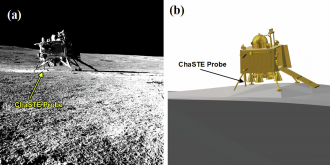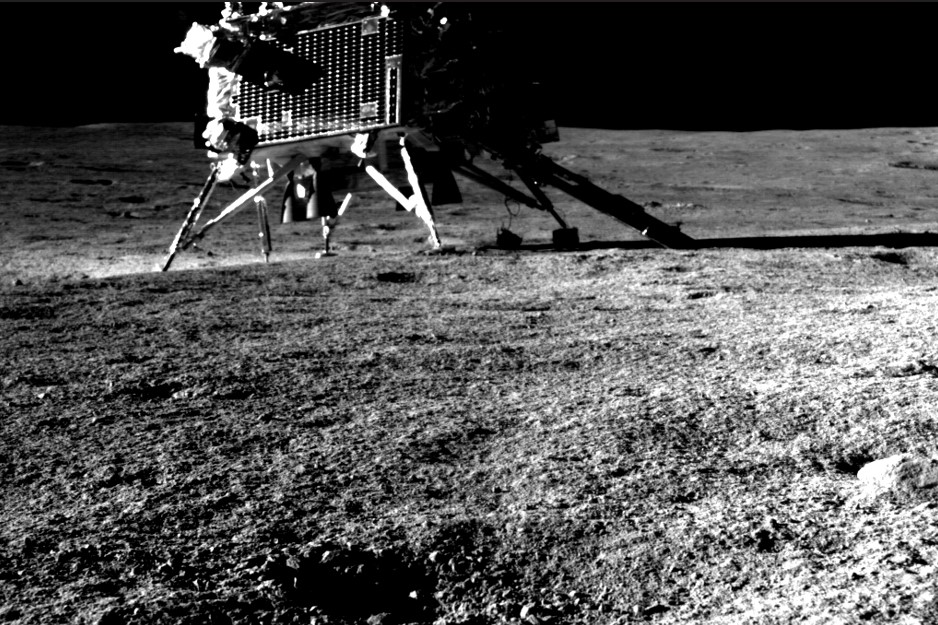Media release
From:
Springer Nature
Planetary science: More potential locations for ice on Moon *IMAGES*
Ice may be present a few centimetres below the Moon’s surface in more areas of the lunar polar regions than was previously thought due to large, yet highly localised, variations in surface temperatures. The results, published in Communications Earth & Environment, are derived from direct measurements taken at the lunar surface in 2023 by the Indian Chandrayaan-3 mission.
Future long-term exploration (or habitation) of the Moon will likely depend on the availability of ice to provide water, with the likelihood of ice formation in a lunar area directly affected by the surface temperature. The only previous direct measurements of the lunar surface temperature were taken during the Apollo missions of the 1970s. However, these missions landed near the equator, several thousand kilometres from proposed landing sites for future manned missions, and where terrain slope has little effect on temperature.
Durga Prasad and colleagues analysed temperature readings taken at the lunar surface and to a depth of 10 centimetres below by ChaSTE — a temperature probe experiment on Chandrayaan-3’s Vikram lander, which touched down at the edge of the south polar region (approximately 69 ° south). The authors found that temperatures at the landing site, a Sun-facing slope angled at 6 °, peaked at 355 Kelvin (82 degrees Celsius) and dropped to 105 Kelvin during the lunar night. However, a lower peak temperature of 332 Kelvin (59 degrees Celsius) was measured on a flat region approximately 1 metre from the lander.
The authors used the collected data to derive a model of how slope angle affects surface temperature at high lunar latitudes similar to the landing site. The model indicated that, for slopes facing away from the Sun and towards the nearest pole, a slope with a greater than 14 ° angle may be cool enough for ice to accumulate close to the surface. This is similar to conditions at the lunar poles, including those at the proposed landing sites for NASA’s manned Artemis missions near the lunar south pole. The authors therefore suggest that areas on the Moon where ice can form may be more numerous and easier to access than previously thought.
Attachments
Note: Not all attachments are visible to the general public.
Research URLs will go live after the embargo ends.

Research
Springer Nature, Web page
The URL will go live after the embargo lifts.
Journal/
conference:
Communications Earth & Environment
Organisation/s:
Physical Research Laboratory, India
Funder:
ChaSTE experiment is supported by Department of Space, Government of
India and jointly developed by Space Physics Laboratory (SPL), Vikram
Sarabhai Space Centre (VSSC), Thiruvananthapuram and Physical
Research Laboratory (PRL), Ahmedabad. We acknowledge the support
provided by various entities of Space Applications Centre (SAC),
Ahmedabad during various phases of development, test and evaluation of
Front-End electronics of ChaSTE.We are immensely grateful to Dr. Veeramuthuvel
andthe entireChandrayaan-3 team, inparticularURRaoSatellite
Centre (URSC), Bangalore; ISRO Telemetry, Tracking and Command Network
(ISTRAC), Bangalore; Satish Dhawan Space Centre (SDSC), Sriharikota,
for their support during various phases of design, development and
operations of ChaSTE.We are immensely thankful to M. Srikanth, Rethika
andmission operations teamfor their support in flawlessly executing various
operational phases of ChaSTE. We specifically thank OHRC team at SAC,
NAVCAM teams at LEOS and Data Processing team at ISTRAC for their
support. We thank Dr. Santosh Vadawale, Dr. Megha Bhatt, Dr. Shanmugam,
Dr. Varun Sheel and other colleagues at PRL for their discussions and
suggestions. Weare extremely thankful toDr. S. Somnath,Chairman, ISRO,
for his continued support to this experiment right from its inception. We are
extremely indebted toShri. A.S. KiranKumar,Chairman,PRLCouncil, for his
meticulous review of ChaSTE during its various phases of development and
in particular for his timely support and suggestions during mission operations.
A.B. was J.C. Fellow during this work. A.G. is a PhD research student
supported by Govt. of India’s DST-INSPIRE fellowship grant during the
period of this work and we thank DST for the same. The computations were
performed ontheParamVikram-1000High PerformanceComputingCluster
of the Physical Research Laboratory (PRL). We thank the anonymous
reviewers for their comments and suggestions. No permissions are required
for geological samples used in the present study.






 International
International



